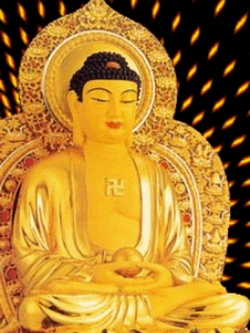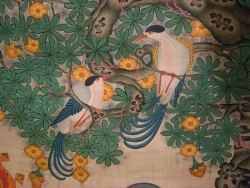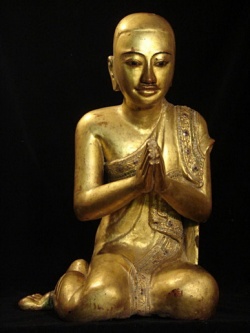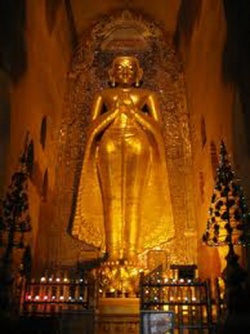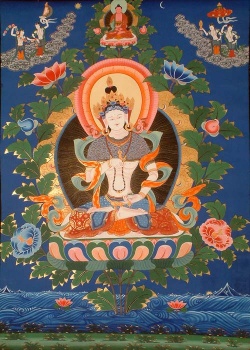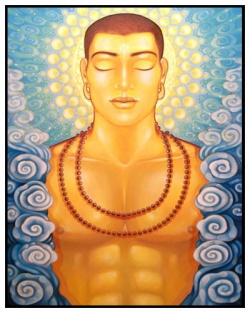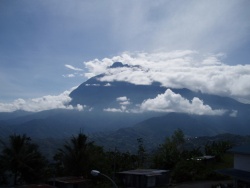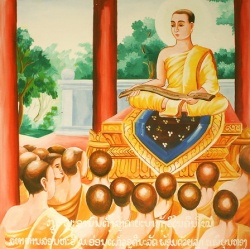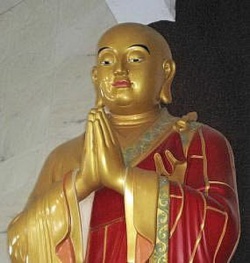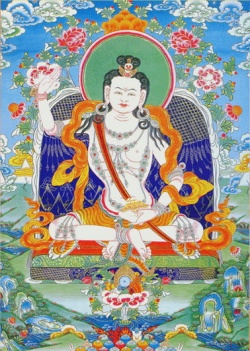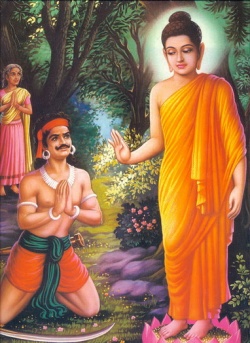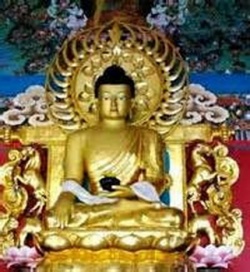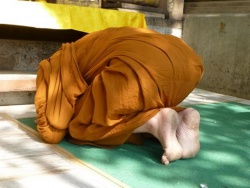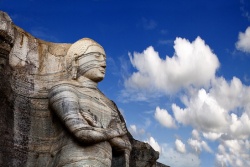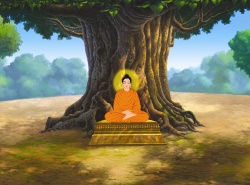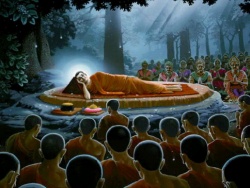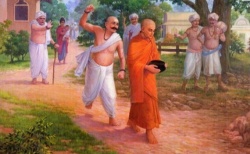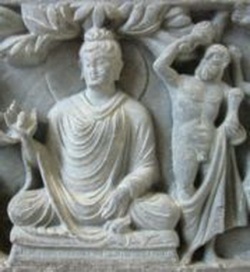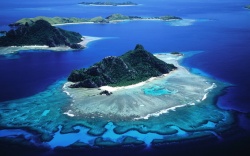A Critical approach into Buddhagosa’s Commentarial Methods
Introduction.
We can see the efforts of protecting the authenticity and the fundamental meaning of the words even in pre Buddhist Vedic texts and this particular trend has been highly accepted in Vedic tradition. Importance of protecting correspondence of words and meaning has implied in Raguvasa by Kalidāsa. This propensity can be considered as the main reason that effected for emergence of commentarial literature. The need of an accurate interpretation of the words of the Buddha was felt even at the lifetime of the Buddha. After the Buddha’s demise, it was very necessary to undertake this task by his chief disciples and this prominent task can be assumed as the root of emergence of commentarial literature. However, to understand the Buddhist doctrine in its main aspect commentarial literature provides a very effective and significant service. Those can be evaluated as the most valuable aid that have ever provided for the proper and scientific study of Buddhist text that known as Tripitaka.
There is only a single name which has remained prominently regarding the commentarial literature which developed the whole Pāli literary tradition and basic researching resources on Pāli canon and that name is ven. Buddhagosa. According to Pāli chronicles, he arrived to Sri Lanka during the reign of King Mahānāma under the instructions of Ven, Revatha and associated the Mahāvihāra which was the main institution of Theravāda tradition to fulfill his goal. As an editor and translator, he performed his task very efficiently and as noted in tradition, obviously in this literary process he was not completely independent, he had to follow the Mahāvihara rules and regulations that known as Mahāvihāranaya.
In this article, I intent to make a critical observation on commentarial methodology of Ven. Buddhagosa, referring his commentaries and modern critics ,which have compiled regarding this context.
The Origin of Commentarial literature
Commentary, which known as Ahakathā means explanation or exposition. This term can separate into two parts as Attha and kathā. Here Attha – meaning and kathā a statement, explanation, or narrative so the meaning of this compound term is explanation of meanings. As mentioned in Sāratthadīpani this known as ahakathā because it describes and spreads meanings. In addition, it has further described in the same text, the miscellaneous discourses delivered by the Buddha in particular places as commentaries. However, regarding with this context ven. Buddhagosa’s definition is very useful to get a clear idea on what commentary is? According to him, commentary means traditional teachings (ācariya vāda) and ācariyavāda is identified with commentaries. In the Sumagalavilāsini he defines “commentary as explanation of connotations.” As asserted by G.P Malalasekara, Ahakathā means “talks about the contents, meaning, or purpose of various parts of the doctrine. He has further explained that the Ahakathā represent the most ancient, orthodox and a traditional interpretation of the Buddha’s teaching.” Here term attha implies eight meanings as reason, wealth, effectiveness, meaning, name, object, aim and significance.
As well as in terms of the Indian tradition, “a commentary means reading new meanings back into old texts according to one’s own educations and outlook. It explains the words and judgments of others and accurately and faithfully as possible. This remarks apply to all commentaries, Sanskrit as Pāli” As mentioned by Ven. Buddhagosa, commentary or Ahakathā is not only a translation of original pāli text though it has gone par excellence over that. As summed up by him in his commentaries explain the difficult words, word-to-word explanation, reason which caused to deliver that, stories, connections what proceeds and what follows. It is very clear that commentary is not a direct translation of a text it should provide philosophical utterances, abstruse points of doctrine that occur in the particular texts. Prof Winter Nitz also has alluded “The Ahakthās, as we know, are exegetical treatises on the texts of the Pāli canon. Their main object was to explain difficult words and abstruse points of doctrine that occur in the texts and also to give additional explanatory information wherever it was necessary”
K.L Hazra has also admitted Ahakathā as explanation of the meaning in his description he has further pointed out that, “the Ahakathās can be mentioned as exegetical treatises on the texts of the pāli canon. Their main object is to give in a clear way explanations of difficult words and points of doctrine that are found in the texts.”
A Commentary should compromise with six meanings known as
· Samkāsanā – Brief explanation, quotation, words and concepts
· Pakāsanā – Publicity or to keep available to read others
· Vivaraā – expressing ideas on particular theme in different ways
· Vibhajanā – method of classification for further explanation
· Utthānikarana – exposition
· Paññatti - topics , designation
And six syllabuses known as,
· akkhara – letters that help understand word in its correct form
· pada - words
· vyañjana- consonants
· nirukkti – Etymological description
· niddesa- Description
· ākāra – Condition
So it is very clear that commentary means a literary portion that has provided for well understand of the Dhamma which is very deep as bhāva and Adhippāya. Fountainhead of this literature runs into the lifetime of the Buddha. The need for an accurate interpretation of the words of the Buddha was felt from very early days, even the lifetime of the Buddha. At that time when disputes arise, regard doctrinal facts then the master undertook the further elucidation or explanation by himself. As well as in some occasions when the doctrine was not well grasped by monks on such occasions it was customary they betake themselves to one of initiated disciple of the Buddha for elucidation or explanation of doctrinal facts. These discussion and explanation can be regarded as the first stage of Buddhist comments and exegetics. Mr B. C law also has admitted these friendly interviews, discussions and analytical expositions as the nucleus of commentaries. In Itivuttaka pāli it has straightly mentioned that “if one does not understand the meaning then he does not realize the doctrine of the Buddha. The Ahakathā or commentaries prominently deal with meaning and various parts of doctrine of the Buddha.”
Vibhangavagga that consists in Majjhimanikāya and the whole Anguttranikāya imply the commentarial features that contain in original Buddhist text. As well as the Cūlaniddesa and Mahāniddesa in Kuddhakanikāya have recognized as commentaries of Ahaka and Pārāyana vagga of Suttanipāta. It sometimes happened that for a proper understanding of the text explanations of a commentarial nature were quite essential and in such a case, the commentary was naturally incorporated into the text and formed part of the text itself. Parivārapāli and Suttavibhanga are great examples for that.
Also regarding this context as mentioned by G.G malalasekara and B.C law who were pioneering modern scholars, commentary originated from the discussion of great teachers. It is no doubt that these fundamental commentarial methodologies were the inspiration of latter commentators. However according to the tradition, Ahakathā composed in the first council. As mentioned by the ven. Buddhagosa in his preface of Sumagalavilāsini, “Aakathā were composed in first council and rehearsed at the two following councils also.”
Yā mahākassapādīhi vasihahakathā purā
Sangitā anusangitā pacchāpica isīhi yā
“This tradition regarding the origin of Ahakathā may be accepted with certain modifications. It is hardly conservable that the original version of the Pāli commentaries as we find them was fixed at the first council soon after the death of the Buddha. But it is very likely that certain abstruse points and ambiguous terms were the topics of discussion at the time of the first council and that definite exposition and meanings to be attached to these were agreed upon. These interpretations would have formed the basis of commentaries of later times. With the development of heretical views and the growth of schisms in the Sagha, at the second and third council the elders who assembled there would have continued this process of interpretation of the Buddha’s teachings.” It is no doubt that the commentarial methodology developed with Pāli canon through some centuries with highly attention of great disciples.
It further contains in the Sumagalavilāsini they were introduced to Ceylon by ven. Mahāmahinda and he also translated them into Sinhala. As asserted by G.P malalasekarathe “commentaries that the Mahāmahinda is said to have brought to Ceylon, along with the canon probably consist of the exposition as laid down at the third council which had just been concluded.” Commentaries that ven. Mahinda transmitted into Sinhala came to be known as Sīhala ahakathā. The earliest record that contains this story is Buddhagosa commentaries. But in Sāratthadīpani sub-commentary of the Vinayapitaka has clearly mentioned reason that caused to translate Pāli commentaries into Sinhala language. According to that allusion, Pāli commentaries have translated to Sinahala to avoid the influence of heretical views of schisms of Saga. The citation implies that Sinhala translation of commentaries is not an one-authored work. This translation has done with interference of community of monks. We can assume that from the 3rd century B.C to 1st centaury A.D these commentaries protected by rote (vācanāmagga nissita). As noted in Dīpavasa and Mahāvasa in the region of kind Vaagāmini Abhaya in the first centaury Pāli canon put into writing along with commentaries. Here as commentaries, it should mean Sīhala akathā. It is not clear that how many books they mean as Sihala akathā, but in main this term referred in Buddhagosa commentaries to indicate the Mahā-aakathā, Mahāpaccariya hakathā and Kurundi-ahakathā. Centauries after the arrival of Mahinda commentaries had developed with the social, philosophical and religious influence of ancient Ceylon. However, Sinhala commentaries which regard as the earliest literally works in Ceylon have been lost and no exist of them in today. Ven. Buddhagosa composed his commentaries associating Sihala hakathā under the instructions of Mahāvihāra, which is the most orthodox and traditional, school in Ceylon at the first half of fifth century. But according to tradition before he arrived to Sri Lanka he composed Atthasālini ahakathā in India. According to the literal proofs, this 5th century A.C can consider as the origination period of Pāli commentaries. So that current Pāli commentaries can consider as back translations, Pāli to Sinhala and again Sinhala to Pāli.
Reasons for translating Sīhala hakathā into Pāli
Sinhala commentaries which do not exist now recognized as the earliest literal works of the Sri Lanka. According to the tradition, commentaries were composed in first council and rehearsed in second and third council. After the third council ven Mahinda brought the Pāli commentaries to Ceylon and translated them into Sinhala for the sake of inhabitants of island, those came to be known as Sihala haktahā. As mentioned by G.P Malalasekara, “by the time of the third council such commentarial literature (using the word in the wider sense) had been more or less fully developed; and when after the conclusion of that synod, Mahinda came to Ceylon, he brought over with him the expositions of the teachings which had been sanctioned by the elders at that meeting. Very soon after Mahinds arrival he translated them into “the language of land” and there they continued to be studied and pondered upon and further developed by the monks of Ceylon.” It is not fair to think that the Sinhalese commentaries remained static in the same form. As asserted by tradition they began in the 3rd century B.C but kept growing and accumulating new material as they passed through the centuries. The signs of their growth, at least up to 2nd century A.C. can be detected. The newly added materials naturally enough, drawn from local incidents and social and religious life of the people of island.
At the contemporary world these Sinhala commentaries may admired as the prominent recourses, which they had on their hand regarding Buddhist canon. Assertion of ven. Revatha who was the Buddhaogs’s preceptor is a great example for that because he has accepted Sīhala hakathā as genuine and most trustful resources they had. Pāli commentaries have noted several names of Sīhalahakathā which existed at that period.
· Mahā hakathā
· Uttaravihāra akathā
· Mahāpaccari-ahakathā
· Andhaka akathā
· Kurundi ahakthā
· Sakhepa hakathā
However, as mentioned in Sāratthadīpani Sri Lankan monks translated Pāli commentaries into Sinhala to avoid the influence of heretical views of schisms of Saga. But latter Buddhagosa translated those commentaries again into Pāli with few editions for the benefits of Bhikkus outside the Ceylon, long life of Dhamma and happy of virtuous men. On the other hand, we can assume that in the concurrent world as a Buddhist institution Abhayagiriya developed and famed internationally more than Mahāvihāra with the influence of Sanskrit language and guardianship of the tooth relic of the Buddha. Under these conditions, Māhāvihāra monks may comprehend well on the value of translating commentaries into Pāli the language that accepted in contemporary world as international communication language. In whatever way we can’t trace the Sīhala akathā in today. It is not known that how and when they disappeared.
Eventually circumstance that effected to translate Sinhala commentaries into Pāli can be categorized as follows.
· For the benefit of monks outside Ceylon
· To the completion of necessary, that collecting the various notions in one common language and becoming to one standpoint.
· As a phase to protect the Dhamma and Vinaya form heretical views.
· For the value that existence of canon and commentary in one language
· Because of, development of Sinhala language, they may assume that it will difficult to understand for latter scholars.
· To make short the detail account.
· For the barring of error and transcription of Sihala akathā
Commentarial methodology of ven. Buddhagosa.
Buddhagosa who was the pioneer of the Pāli commentarial literature compiled his commentaries using Sīhalahakathā and many other traditional resources. Current Pāli commentaries existed early in Pāli and they translated into Sinhala, but again they translated into Pāli. Thus, the Buddhagosa’s commentaries can recognize as retranslated commentaries. Modern scholars prefer very much to accept Buddhagosa’s commentaries as editions rather than translations. While compiling the Pāli commentaries Buddhagosa has used a constructive writing style. There are so many modern critics regarding the commentarial methodology which used by ven. Buddhagosa.
According to the Prof. Gatāre Dhammapāla Buddhagos’s commentaries are not verbatim translations he has composed them paying special attention on preservation of identify of meaning.
As G.P Malalasekara asserts, the author of a systematic and coherent a synopsis as the Visuddhi – magga could not rest content with a mere translation; for that no great ability was required, and certainly far less extraordinary talent that he possessed. He wished to collect and systematize the knowledge, which the various works contained, to garner the criticism of ancient scholarship for the use of future generation of scholars.”
Ven. Walpola Rahula says, Buddhagos’s work was that of an editor – translator, but he seems to have performed his task so efficiently and with such discretions and authority that now he is regarded more or less as the author of commentaories.”
Buddhagosa describes himself what he did in the metrical introduction to the Samantapāsādika, “in commencing this commentary – having embodied therein the Mahā-ahakathā without excluding any proper meaning form the decisions contained in the Mahāpaccari, as also in the famous Kurundi and other commentaries, and including the opinions of the elders – I shall perform my task well. Let the young and the middle aged and the elderly monks who entertain a proper regard for the doctrines of the Tathāgatha, the luminary of truth, listen to my words with pleasure. The Dhamma as well as the Vinaya was declared by the Buddha and his sons understood it in the same sense as it was delivered, and inasmuch as in the former time they (the Sinhalese commentators) composed the commentaries without disregarding their (sons) opinions, therefore, excepting any error of transcription, everything contained therein is an authority to the learned in this order, who respect ecclesiastical discipline form these commentaries, after casting off the language, condensing detailed accounts, including authoritative decisions, without overstepping any Pāli idiom (I shall proceed to compose my work). And, as this commentary will be explanatory of the meanings of words belonging to the Suttas in conformity with the sense attached to them therein, therefore ought it more diligently to be studied.” In his Nikāya commentaries he sheds lights further; “ and now rejecting the Sinhala language, adopting the graceful language that accords so well with the order of the text, not contradicting the faultless conclusions of the elders of the priesthood who dwell at the great monastery…. And to the end that religion may long endure, I proceed to expound the meaning of my text, omitting all unnecessary repetitions.”
In terms of above connotation, it can clearly identify some special translation techniques used by Buddhaoga in his commentaries.
Ø Including all proper meanings, that contain in primary sources. (Yo utthamattha aparicchajanto)
Ø Including the opinion of the elders (Antogadha theravāda)
Ø Barring any error of transcription (Ta vajjayitvāna pamādalekha)
Ø Casting off only the language (Tatova bhāsantarameva hitvā)
Ø Condensing detail accounts (Vitthāramaggañca samāsaitvā)
Ø Including authoritative decisions ( Vinicchaya sabbamasesaitvā)
Ø Without overstepping any Pāli idioms ( Tantikkama kanchi avokkamitvā)
including all proper meanings, contain in Primary sources.
It is very clear that the work before Buddhagosa was by no means an easy one in anyway. The very copiousness of the material was an embracement. When he set out from India having made his concise commentary, his idea was merely to study the Sinhala Ahakathā and to translate them into Pāli. But now, faced often with conflicting views, contradictory assertions, and sometimes incompatible doctrines, he has to expunge, abridge, enlarge, and make a new a commentary of this own.” So he wished to collect and systematize the knowledge which the various works contain and the garner of the criticism of ancient scholarship for the benefit of future generation. therefore, he did not shrink form rewriting them so as to expand what he found into a fuller and richer form, to illuminate and elucidate the text of his comment. But he approached to his task with no iconoclastic desire to supersede the earlier scholiasts, on the contrary, he studied with great assiduity what his predecessors has written and incorporated pious care in their works. He has one great object predominantly in view, namely, to inspire reverence for what he considered supreme authoritative. If he can completely agree with the description that consist in primary sources at outright he has accepted that (Ya aakathāsu vutta ta suvuttameva)
Thus Buddhagosa’s work formed a synthetic unity, deliberately planned as a consistent scheme for dealing with the traditions which had come down through the centuries, handed down by distinguish members of the order and ever growing in the scope of their expositions of the canon.
Including the opinions of the elders
Including the opinions of the elders’ means being partially to Theravada, or in other words obeying to Mahāvihāra tradition. Traditional commentaries were protected in Mahāvihāra that consider as the most prominent orthodox institution of Theravada Buddhism. They protected them avoiding any space of entering heretical views. As well as with the increasing of power of Abhyagiriya caused to monks of Mahāvihāra to be cautious in welcoming a Indian monk like Buddhagosa who came to translate orthodox Sinhala commentaries into Pāli for the benefit of Indian Buddhism. That is why firstly they check the abilities of the Buddhagosa before giving permission to access into the Mahāvihāra library. Therefore, to achieve his goal and compilation of his purpose Buddhagosa had to submissive the Mahāvihāra tradition. In his commentaries Buddhagosa has pledged his allegiance to the Mahāvihāra tradition.
· Mahāvihāravāsīna desanā nayanissita
· ācariyavāda avihāya vibhajjavādīssāna
· samaya avilomanto therāna theravasadipāna
· Suipunavinicchayāna mahāvihārādivāsīna
· Mahāvihāravāsīna vācanāmagganissita
· Mahāvihāravāsīna dīpayanto vinicchaya
· Suvisuddha asakia niputthavinicchaya
· Mahāvihāravāsīna samaya avilomaya
Here the term Samaya indicate the boundaries that imposed by Mahāvihāra monks to Buddhagosa. Vibhanga hakthā which known as Sammodhavinodani consists a clear description about the Mahāvihāra manner.
Tassā atthasavaana karontena,
· Vibhajjhavādi mandala otāretvā
· Sakasamaya avokkamantena
· Parasamaya anāhuyantena
· Sutta appatibhāgantena
· Vinaya anulomantena
· Mahāpadese olokentena
· Dhamma dīpentena
· Attha Sangāhantena
· Thamevattha upaparikkhantena
· Aparehipi Pariyāyehi niddissantena
Ca yasmā attha savaā kātabbā hoti
As mentioned in above quotations it is fixed that Buddhagosa agreed to follow these ten facts in his commentaries. However, regarding these ten factors Dr. Aruna K. Gamage has mentioned an opposite notion in his one article. As he alluded, these ten facts are not an act that compulsory to follow by commentators while they compiling their commentaries. That is only the system that he followed while describing the dependent co- origination in accordance with Theravada tradition. It should emphasis that there are not any evidences in commentaries to conclude that as law of Mahāvihāra. But as mentioned in the Pāli canon even in the life time of the Buddha if it arise any kind of doubt regarding doctrinal facts Buddha has preached Satharamahāpadesa (fourfold statements ) to correct those wrong views. In other hand, Buddhagosa undertook this literal process about ten centuries after the demise of the Buddha. So in course of time with the influence of heretical views of various sects and with the development of Abhyagiriya, it was very essential of a clear standpoint to assay the correctness of doctrinal views. As well as, we can assume that Mahāvihāra monks were very cautious while dealing with a south Indian monk who wants to translate Sīhala hakthā into Pāli which protected by Mahāvihāta monks having offered their lives. Thus it is very fair to think that those facts as a way of methodology that they used to avoid the difficulties of their compilations. On the other hand, we can assume that these theories had followed by Mahāvihāra monks to omit the variations and defectives consist in sources, and choose the correct philosophy of the Buddha. This same manner has may introduced to the Buddhagosa by Mahāvihāra monks to fulfill his compilation of Pāli commentaries. When analyzing Buddhagosa commentaries it is very clear that he has associated not only Mahāvihāra tradition but also many traditional resources to complete his literal purposes. However, he has expressed that in his every commentary, as a standpoint to follow the Mahāvihāra tradition and compile his commentaries without including sectarian notions.
Just as Mahāvihāra monks were cautious in welcoming Buddhagosa, he also was careful in introducing any new idea into Mahāvihāra tradition in a way that was too obvious. “one prominent example shows how Buddhagosa achieved his goal. In the commentary on the Dhammasagini, Buddhagosa makes a very important remark regarding the theory of moments (khanavāda). He says, herein, the following present (santatipacuppanna) finds mention in the commentaries (akathā), the enduring present (addhā- paccppanna) in the discourses (sutta). Some say (kecivadanti) that the thought existing in the momentary present (khanapaccuppanna) becomes the object of telepathic insight.” As well as “Buddhagosa is very cautious when he deals with canonical matters left unexplained in the commentaries what were before him. Sometimes he explains a point and hastens to add a clause of apologetic warnings; as this has not been handed down in the commentaries, it should be accepted after investigations. (ahakathāsu pana anāgatatthā vīmansetvā gahetabba). Even when Buddhagosa is forced by his own reasoning to disagree with the ahakthās he hesitated to give his definite opinion. “As it is said in all the Aakathās” he says sometimes “it is not possible to reject (the explanation) what is correct should be found out or the commentators should be taken on trust.”
Barring any error and repetition of transcriptions
In the prefaces of Buddhagosa commentaries he has clearly mentioned the way that he going to exegesis. As mentioned in those one of his very important exegetical technique is barring error and repetition of transcriptions (āropento vigatadosa, hitvā punappunāgatamattha attha pakāsaissāmi).
It is no doubt that the Sīhalaakathā had international standard in contemporary literal background. That is why ven. Revath who was the preceptor of Buddhagosa inspired him to go to Ceylon and translate sīhalaṭṭakathā into Pāli. However, in course of the development of the Sinhala aakathā we can expect of deviations and repetitions. Thus, “Buddhagosa has mentioned as a part of his task in his translation the removal of the errors and repetitions, which he found in the originals. There were also places where an explanation did not tally with the canonical text and where Buddhagosa had to give preference to the latter.” Sometimes he has critiques those deviations and repetitions. As examples in Samantapāsādikā showing the deviations in Andakaakathā he has showed those faults and also sometimes he has harsh in criticism as follows. “This is wrongly said”[1] “that agrees neither with the Aakathā nor with the canon, and therefore should not be accepted”
He has followed a special method to bar the repetitions form his commentaries. Firstly he composed Visuddhimagga as the common commentary for canon. Then in his other commentaries if there is something which he had descried earlier in Visuddhimagga or any other commentary in such occasions he has refer readers to those commentaries.
Casting off only the language
This means using Pāli language instead of Sinhala language without changing the particular content. Nevertheless, it is very difficult to prove through examples because of unavailable of Sīhalaakathā.
Condensing detail accounts
It is no doubt that the Sinhalese commentaries did not remain static in the same form, they began in the 3rd century B.C but kept on growing and accumulating new material as they passed through the centuries.” The newly added material was, naturally enough drawn from local incidents and social and religious life of the people of the island. The purpose of adding this new local material was not to teach history or local conditions, but to illustrate or elucidate doctrinal and ethical points in a striking and homely manner.” In course of his explanation, Buddhagosa says, in his introduction to the commentaries “ he only translated these Sinhalese commentaries into Pāli and in so doing he left out unnecessary details and repetitions as well as irrelevant matter, (vitthāramaggaca samāsaitvā) but without prejudice to the traditions of the Mahāvihāra. Some of material thus left out, though not useful to this purpose. It was left out perhaps because it was too well known to the people at that time. That those stories were well known by both preacher and their audiences is evident from the fact that Buddhagosa in many places only refers to them but does not give them in full. For instance, in Visuddhimagga he says, (Telakandarika – vatthu cettha kathetabba) here the story of Telakandarika also should be related”. So there are enough reasons to believe that that there was a common stock of fables and legends in ancient Ceylon which commentators borrowed abundantly whenever they were in need of a story to illustrate a point or to gratify the religious sentiments of the devotees. An example for this is found In the Samantapāsādikā where Buddhaogsa says that the “ Mahā hakathā contained detail accounts on certain subjects, but he does not proceed to include them.
As well as in many occasions he has thoroughly emphasis that in his literal purpose he takes only the substance from commentaries. Mulahakathā sāra ādāya ima mayā karontena, Porānaakathāna sāra ādāya imamayā niha pattā So it is very obvious that pāli commentaries are not mere translation of Sinhala commentaries.
Including authoritative decisions
Buddhagosa’s work appears to have been to make a critical study of not only the different Sinhala and Dravidian commentaries but also the other source of material, such as the canon and various traditions and opinions. When it appear disparities regarding the same context in various commentaries, in such cases “the interpretations given in the several commentaries are recorded and the decision is left open.” If there any doubts in primary sources he has urged readers to pay attention and analyze that (Sabbaakathāsu pana vuttantā na sakkā patiseditu gavesitabbā ettha yutti).
Undeviating any Pāli idioms
Original Pāli canon was the median of Buddhagosa’s work. So Buddagosa has often compared commentarial interpretations with the canonical and where it disagrees, it has rejected. It implies that if any point of view the Mahāvihāra traditions contradict with canon then he had a right to discard that also. Where there were interpretations of Sīhala hakathā does not tally with canon where Budhagosa had to give preferences to the latter. He has used comparing doctrinal facts with Dhamma and Vinaya as the criteria to get the real idioms of Pāli. However, commentators hadn’t any permission to conclude this is Sutta or this is Vinaya. So they were in controversial stage regarding these criteria. Not only has that even ācariyavāda contradicted with canon Buddhagosa has rejected that also.
Ācariyavāda
The individual views or opinions expressed by well-known teachers who have specialized knowledge of canon are classed as the ācariyavādas (exposition of the elders). Among the individual opinions recorded are those of Dīgabhānaka tepitaka mahāsiva, tepitaka culābhaya, Tepitaka mahādhammarakkhita, Tepitaka culanāga, Moravāpivāsi Mahādatta and Mahāsiva thera. However, “these opinions if they are not corroborated by text or the commentary are not to be regarded as essential correct. Similar in significance to the ācariyamatas are the expositions attributed to the ācariyas referred to often in the Pāli commentaries as ācariyā vadanti, ācariyā katayanti” Great example shows to this in the Atthasālini,
“ekacce ācariyā ekavāra hotī’ti; vadanti”
Bhānakamata
Buddhagosa has also made fairly wide use of the tradition handed down by the Bhānakās. Bhānakās mean recitors of various portions of the canon. There were the Bhānakās of the Digha, Majjhima, Aguattara, Samyuttanikāyas, of the two Vibhngās and of the Dhammapada. It is not known whether the views of the Bhānakās were already found in Sīhalahakathā or alternatively, in what form they were available. However Buddhagosa has used many references of Bhānakās in his commentaries. As an example,
· Majjhima bhānakā pana eva vadanti
Porāamata.
Several interpretations have been put forward by scholars regarding term Porāna. According to Rhys Devids “they are the fathers of Theravāda sāsana. Commentaries contain numerous quotations from the Porāā which for the most part are introduced with the words” tenāhu porāā” it imply that porāās have touch upon variety of subjects. As an example can quote few quotations,
· Tenevassa porāā eva vacanattha vadanti
· Porāā pana ‘‘addhāne gacchante na paññāyissati, jīraasabhāvo pana na hotiyevā’’ti vadanti.
N.A Jayathilaka opines Porāamata as well accepted views or explanations on Buddhism.
Attanomati (presenting his own opinion)
Whenever Buddhagosa has to give his own views on any point, compelled to do so by the absence of any explanation elucidating it in the Sinhalese commentaries with the note of “avicāritameta porānehi aya pana me attano mati” he has mentioned the views of his own.
Pathavi abhinandatīti vuttappakārameva pathavi tahādīhi abhinandati, assādeti, parāmasati cāti vutta hoti. ‘‘Pathavi maññatī’’ti eteneva etasmi atthe siddhe kasmā eta vuttanti ce. Avicāritameta porāehi. Aya pana me attano mati,
Providing philological explanations
Ven. Buddhagosa has tried to explain every doubtful words and phrases. In this exercise, he has associated way of philological explanation also. While he explains word or phrase, he has given derivation and grammatical explanation of particular word or phrase.
· Kho’ti avadhāranatthe padapūranamatte vā nipāto
· Paccatta parasena jinātīti pasenadi
· Tathāgatassāti ahahi kāraehi bhagavā tathāgato ,Tathā āgatoti tathāgato, tathā gatoti tathāgato tathalakkhaa āgatoti tathāgato, tathadhamme yāthāvato abhisambuddhoti tathāgato, tathadassitāya tathāgato, tathavāditāya tathāgato, tathākāritāya tathāgato, abhibhavanahena tathāgatoti.
Providing philosophical ideas.
While defining doctrinal facts ven. Buddhagosa has tried to explain those doctrinal points in a vast philosophical context.
“Imā kho cittāti oāriko attapailābho iti ca manomayo attapailābho iti ca arūpo attapailābho iti ca imā kho citta lokasamaññā loke samaññāmattakāni samanujānanamattakāni etāni. Tathā lokaniruttimattakāni vacanapathamattakāni vohāramattakāni nāmapaattimattakāni etānīti. Eva bhagavā hehā tayo attapailābhe kathetvā idāni sabbameta vohāramattakanti vadati. Kasmā? Yasmā paramatthato satto nāma natthi, suñño tuccho esa loko”
Here mainly he has paid his attention on the philosophical side of the matter rather than describing or providing etymological descriptions.
Providing a inception stories
Providing inception stories or Nidhānakathās can acquaint as a special feature of the Buddhagosa commentarial methodology. Here through providing inception stories he has tried submit the historical background or the reason that effected to deliver particular discourse. The Abhidhammanidhānakathā or the inception story of the Abhidhammapiaka is a very great example on this context.
Pāricchattakamūlamhi, paukambalanāmake
Silāsane sannisinno, ādicco’va yugandhare.
Cakkavāasahassehi, dasahāgamma sabbaso;
Sannisinnena devāna, gaena parivārito.
Mātara pamukha katvā, tassā paññāya tejasā;
Abhidhammakathāmagga, devāna sampavattayi.
Herein through inception story ven. Buddhaosga has describe when, where, how, why and to whom this discourse delivered. There are so many modern critiques on the credibility this inception story; however those reveal an important aspect of the commentarial methodology of ven, Buddhagosa.
Presenting Parables.
To emphasize or describe something further or in detail ven. Buddhagosa has used similes and parables very efficiently. As an example in Majjhimanikāhakathā while describing Mano viññāa for the further understand and the better apperception of reader Buddhagosa has describe Pañcaviññāa via very interesting similes.
Ex.
Tatrāya upamā – pañca kira dubbalabhojakā rājāna sevitvā kicchena kasirena ekasmi pañcakulike gāme parittaka āya labhisu. Tesa tattha macchabhāgo masabhāgo yuttikahāpao vā, bandhakahāpao vā, māpahārakahāpao vā, ahakahāpao vā, soasakahāpao vā, bāttisakahāpao vā, catusahikahāpao vā, daoti ettakamattameva pāpuāti. Satavatthuka pañcasatavatthuka sahassavatthuka mahābali rājāva gahāti. Tattha pañcakulikagāmo viya pañca pasādā dahabbā; pañca dubbalabhojakā viya pañca viññāāni; rājā viya javana; dubbalabhojakāna parittaka āyapāpuana viya cakkhuviññāādīnarūpadassanādimatta. Rajjanādīni pana etesu natthi. Rañño mahābaliggahaa viya tesu dvāresu javanassa rajjanādīni veditabbāni
Conclusion.
Considering the Buddhagosa’s rank in the Buddhist world undoubtedly he is the greatest commentator and exegetist. The service that he rendered to Buddhism was the most useful and enduring one and Buddhist followers are gratitude to his service. It is very suitable to grant that as Mr Rhys Devids says that the method adopted in his commentaries follows very closely the method of those much older ones preserved in the canon, but the literal skills with which he used it is a great advance, more especially in lucidity, over older documents. Obviously Buddhist way of explanation that trace to the life time of the Buddha has systematized and given it’s perfect and final shape by Buddhagosa through his commentaries using traditional and his own methodological ways. Result of this great service the philosophical ides scattered in the Tripitaka can be found in a systematic form in his commentaries.
